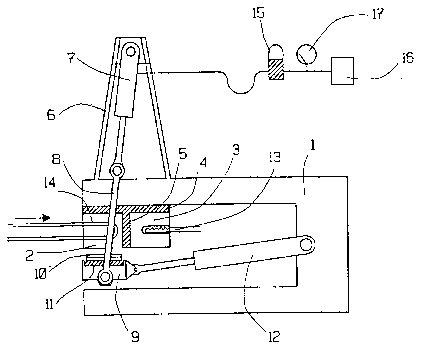Une partie des informations de ce site Web a été fournie par des sources externes. Le gouvernement du Canada n'assume aucune responsabilité concernant la précision, l'actualité ou la fiabilité des informations fournies par les sources externes. Les utilisateurs qui désirent employer cette information devraient consulter directement la source des informations. Le contenu fourni par les sources externes n'est pas assujetti aux exigences sur les langues officielles, la protection des renseignements personnels et l'accessibilité.
L'apparition de différences dans le texte et l'image des Revendications et de l'Abrégé dépend du moment auquel le document est publié. Les textes des Revendications et de l'Abrégé sont affichés :
| (12) Demande de brevet: | (11) CA 2192059 |
|---|---|
| (54) Titre français: | DISPOSITIF DE PRESSAGE DE PLASTIQUES |
| (54) Titre anglais: | A DEVICE FOR PRESSING PLASTICS |
| Statut: | Réputée abandonnée et au-delà du délai pour le rétablissement - en attente de la réponse à l’avis de communication rejetée |
| (51) Classification internationale des brevets (CIB): |
|
|---|---|
| (72) Inventeurs : |
|
| (73) Titulaires : |
|
| (71) Demandeurs : |
|
| (74) Agent: | MARKS & CLERK |
| (74) Co-agent: | |
| (45) Délivré: | |
| (86) Date de dépôt PCT: | 1995-06-08 |
| (87) Mise à la disponibilité du public: | 1995-12-21 |
| Licence disponible: | S.O. |
| Cédé au domaine public: | S.O. |
| (25) Langue des documents déposés: | Anglais |
| Traité de coopération en matière de brevets (PCT): | Oui |
|---|---|
| (86) Numéro de la demande PCT: | PCT/SE1995/000687 |
| (87) Numéro de publication internationale PCT: | WO 1995034419 |
| (85) Entrée nationale: | 1996-12-04 |
| (30) Données de priorité de la demande: | ||||||
|---|---|---|---|---|---|---|
|
L'invention concerne un appareil de pressage de plastiques comprenant un outil de pressage destiné à être pressé contre une surface de pressage chauffée ou refroidie et régulée par thermostat, à l'aide d'un moyen de pression. La surface de pressage comporte une surface plane commune à un dispositif froid régulé par thermostat (2) et à un dispositif chaud régulé par thermostat (3), et l'outil (10) peut être déplacé d'un dispositif régulé par thermostat (2) à l'autre dispositif régulé par thermostat (3), l'invention permettant de modifier rapidement la température de l'outil (10) et de la pièce de plastique qu'il contient, et ce en même temps que la pression est appliquée.
The present invention relates to plastic pressing apparatus comprising a press
tool which is adapted to be pressed against a thermostat-controlled heated or
cooled press surface with the aid of pressure means. According to the
invention, the press surface includes a flat surface which is common to a
thermostat-controlled cold device (2) and a thermostat-controlled hot device
(3), and the tool (10) can be moved from one thermostat-controlled device (2)
to the other thermostat-controlled device (3) with the invention of varying or
modifying the temperature of the tool (10) and the plastic workpiece enclosed
therein quickly and at the same time as the pressure is applied.
Note : Les revendications sont présentées dans la langue officielle dans laquelle elles ont été soumises.
Note : Les descriptions sont présentées dans la langue officielle dans laquelle elles ont été soumises.

2024-08-01 : Dans le cadre de la transition vers les Brevets de nouvelle génération (BNG), la base de données sur les brevets canadiens (BDBC) contient désormais un Historique d'événement plus détaillé, qui reproduit le Journal des événements de notre nouvelle solution interne.
Veuillez noter que les événements débutant par « Inactive : » se réfèrent à des événements qui ne sont plus utilisés dans notre nouvelle solution interne.
Pour une meilleure compréhension de l'état de la demande ou brevet qui figure sur cette page, la rubrique Mise en garde , et les descriptions de Brevet , Historique d'événement , Taxes périodiques et Historique des paiements devraient être consultées.
| Description | Date |
|---|---|
| Inactive : CIB de MCD | 2006-03-12 |
| Le délai pour l'annulation est expiré | 2003-06-09 |
| Demande non rétablie avant l'échéance | 2003-06-09 |
| Inactive : Renseign. sur l'état - Complets dès date d'ent. journ. | 2002-07-23 |
| Inactive : Abandon.-RE+surtaxe impayées-Corr envoyée | 2002-06-10 |
| Réputée abandonnée - omission de répondre à un avis sur les taxes pour le maintien en état | 2002-06-10 |
| Demande publiée (accessible au public) | 1995-12-21 |
| Date d'abandonnement | Raison | Date de rétablissement |
|---|---|---|
| 2002-06-10 |
Le dernier paiement a été reçu le 2001-05-29
Avis : Si le paiement en totalité n'a pas été reçu au plus tard à la date indiquée, une taxe supplémentaire peut être imposée, soit une des taxes suivantes :
Veuillez vous référer à la page web des taxes sur les brevets de l'OPIC pour voir tous les montants actuels des taxes.
| Type de taxes | Anniversaire | Échéance | Date payée |
|---|---|---|---|
| TM (demande, 3e anniv.) - générale | 03 | 1998-06-08 | 1998-06-03 |
| TM (demande, 4e anniv.) - générale | 04 | 1999-06-08 | 1999-05-31 |
| TM (demande, 5e anniv.) - générale | 05 | 2000-06-08 | 2000-05-30 |
| TM (demande, 6e anniv.) - générale | 06 | 2001-06-08 | 2001-05-29 |
Les titulaires actuels et antérieures au dossier sont affichés en ordre alphabétique.
| Titulaires actuels au dossier |
|---|
| TELEFONAKTIEBOLAGET LM ERICSSON |
| Titulaires antérieures au dossier |
|---|
| KARL-ERIK LEEB |